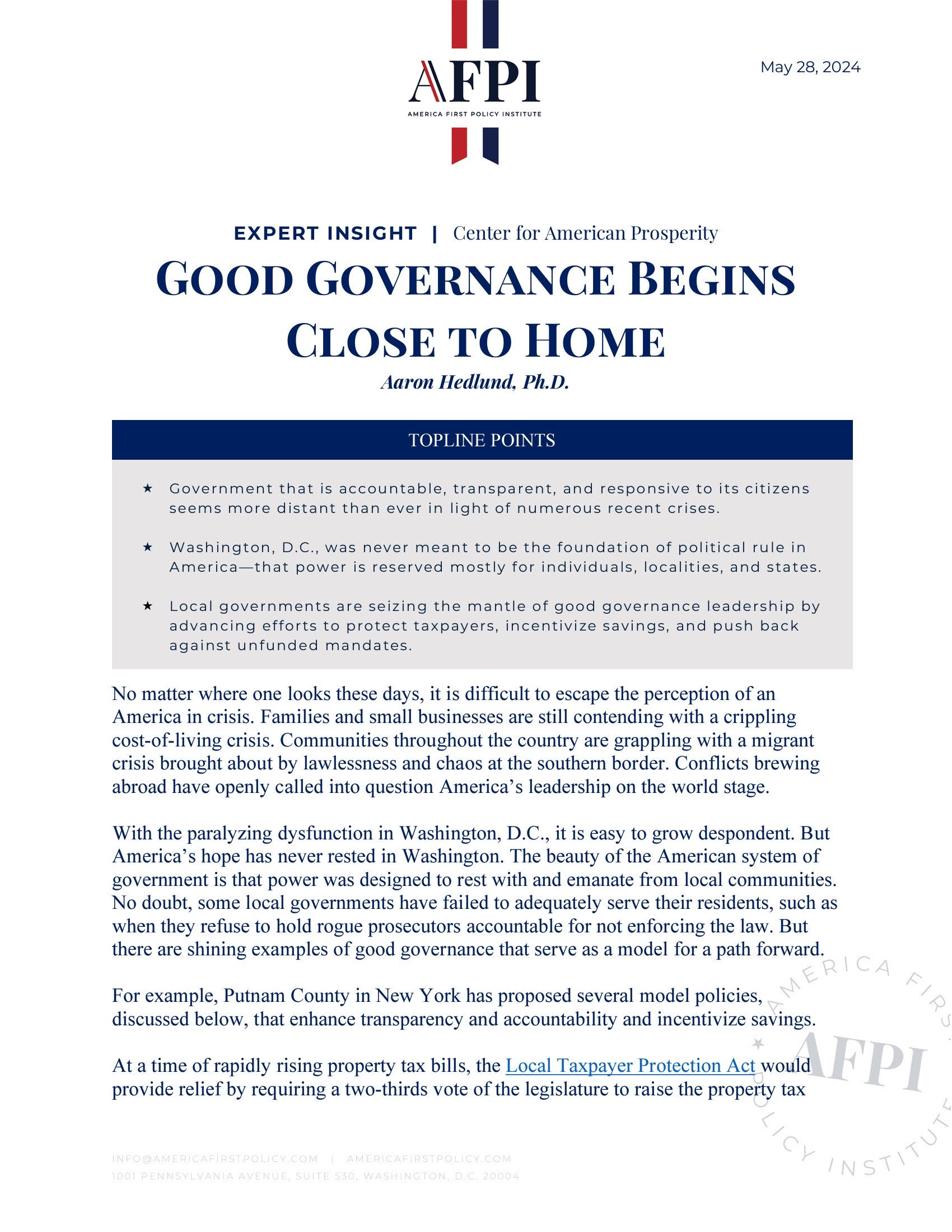Good Governance Begins Close to Home
Key Takeaways
Government that is accountable, transparent, and responsive to its citizens seems more distant than ever in light of numerous recent crises.
Washington, D.C., was never meant to be the foundation of political rule in America—that power is reserved mostly for individuals, localities, and states.
Local governments are seizing the mantle of good governance leadership by advancing efforts to protect taxpayers, incentivize savings, and push back against unfunded mandates.
No matter where one looks these days, it is difficult to escape the perception of an America in crisis. Families and small businesses are still contending with a crippling cost-of-living crisis. Communities throughout the country are grappling with a migrant crisis brought about by lawlessness and chaos at the southern border. Conflicts brewing abroad have openly called into question America’s leadership on the world stage.
With the paralyzing dysfunction in Washington, D.C., it is easy to grow despondent. But America’s hope has never rested in Washington. The beauty of the American system of government is that power was designed to rest with and emanate from local communities. No doubt, some local governments have failed to adequately serve their residents, such as when they refuse to hold rogue prosecutors accountable for not enforcing the law. But there are shining examples of good governance that serve as a model for a path forward.
For example, Putnam County in New York has proposed several model policies, discussed below, that enhance transparency and accountability and incentivize savings.
At a time of rapidly rising property tax bills, the Local Taxpayer Protection Act would provide relief by requiring a two-thirds vote of the legislature to raise the property tax levy on county residents. It also would strengthen the voices of residents by mandating the livestreaming of all public budget meetings and ensuring that residents have a chance to ask questions and provide comments whenever a tax increase is considered.
The Taxpayer Transparency Act addresses a frustrating problem that citizen watchdogs have no doubt encountered across the country, which is the difficulty of locating and deciphering local budget data. In many cases, local governments either do not make this data public or place it online in an unusable, unsearchable format. This model policy would require governments to maintain a searchable budget database that includes extensive information beyond the amount spent. The database would also include the purpose of each budget program, expected performance outcomes, and audits that show whether the programs are achieving their stated ends. With this database at their fingertips, citizens would be in a position to ask tough questions of local leaders and not be disadvantaged by a lopsided asymmetry of information. This model policy is in the same spirit as the Transparent Local Accounting initiative by Strong Towns, which emphasizes three key pillars: local accounting must make sense; local accounting must be accurate; and local accounting must be accessible to locals, not just Wall Street insiders.
One longstanding incentive problem in government is that agencies try hard not to find savings because they fear it will cause public officials to cut the agency’s budget out of the belief that not as much is needed. The Savings Incentive Partnership Program addresses this dysfunctional feature of government in an innovative way by directly rewarding non-managerial public employees who submit proposals that lead to tangible net savings across government. In other words, if an employee comes up with an innovative cost-saving solution, that employee reaps a direct benefit.
Lastly, many localities continue to deal with the practice of unfunded mandates imposed by other levels of government looking to evade their own responsibilities. The migrant crisis is just the latest manifestation of this temptation. The original sin in this case is the Biden Administration abdicating its duties to secure the border, forcing cities across the country to deal with the consequences of border chaos. But the problem is not confined to large cities. When New York City decided that it no longer wanted to deal with the problem, it started shifting the burden to surrounding communities like Putnam County. In response, the Homelessness Crisis Mitigation Act would ban external municipalities from establishing temporary housing within a different county without first establishing a shared services agreement to ensure proper coordination.
Conclusion
Each of these pieces of model legislation is proof that good governance does not have to wait for the federal government. Localities can—and in some cases do—take the lead.
